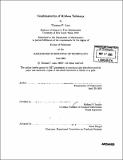| dc.contributor.advisor | Richard P. Stanley. | en_US |
| dc.contributor.author | Lam, Thomas F. (Thomas Fun Yau) | en_US |
| dc.contributor.other | Massachusetts Institute of Technology. Dept. of Mathematics. | en_US |
| dc.date.accessioned | 2006-02-02T18:54:39Z | |
| dc.date.available | 2006-02-02T18:54:39Z | |
| dc.date.copyright | 2005 | en_US |
| dc.date.issued | 2005 | en_US |
| dc.identifier.uri | http://hdl.handle.net/1721.1/31166 | |
| dc.description | Thesis (Ph. D.)--Massachusetts Institute of Technology, Dept. of Mathematics, 2005. | en_US |
| dc.description | Includes bibliographical references (p. 83-86). | en_US |
| dc.description.abstract | This thesis begins with the study of a class of symmetric functions ... Which are generating functions for ribbon tableaux (hereon called ribbon functions), first defined by Lascoux, Leclerc and Thibon. Following work of Fomin and Greene, I introduce a set of operators called ribbon Schur operators on the space of partitions. I develop the theory of ribbon functions using these operators in an elementary manner. In particular, I deduce their symmetry and recover a theorem of Kashiwara, Miwa and Stern concerning the Fock space F of the quantum affine algebras ... Using these results, I study the functions ... in analogy with Schur functions, giving: * a Pieri and dual-Pieri formula for ribbon functions, * a ribbon Murnaghan-Nakayama formula, * ribbon Cauchy and dual Cauchy identities, * and a C-algebra isomorphism ... The study of the functions ... will be connected to the Fock space representation F of ...via a linear map [Iota]: F ... which sends the standard basis of F to the ribbon functions. Kashiwara, Miwa and Stern [29] have shown that a copy of the Heisenberg algebra H acts on F commuting with the action of ... Identifying the Fock Space of H with the ring of symmetric functions A(q) I will show that · is in fact a map of H-modules with remarkable properties. In the second part of the thesis, I give a combinatorial generalisation of the classical Boson-Fermion correspondence and explain how the map [phi] is an example of this more general phenomena. I show how certain properties of many families of symmetric functions arise naturally from representations of Heisenberg algebras. The main properties I consider are a tableaux-like definition, a Pieri-style rule and a Cauchy-style identity. | en_US |
| dc.description.abstract | (cont.) Families of symmetric functions which can be viewed in this manner include Schur functions, Hall- Littlewood functions, Macdonald polynomials and the ribbon functions. Using work of Kashiwara, Miwa, Petersen and Yung, I define generalised ribbon functions for certain affine root systems 1 of classical type. I prove a theorem relating these generalised ribbon functions to a speculative global basis of level 1 q-deformed Fock spaces. | en_US |
| dc.description.statementofresponsibility | by Thomas F. Lam. | en_US |
| dc.format.extent | 86 p. | en_US |
| dc.format.extent | 5104078 bytes | |
| dc.format.extent | 5113479 bytes | |
| dc.format.mimetype | application/pdf | |
| dc.format.mimetype | application/pdf | |
| dc.language.iso | eng | en_US |
| dc.publisher | Massachusetts Institute of Technology | en_US |
| dc.rights | M.I.T. theses are protected by copyright. They may be viewed from this source for any purpose, but reproduction or distribution in any format is prohibited without written permission. See provided URL for inquiries about permission. | en_US |
| dc.rights.uri | http://dspace.mit.edu/handle/1721.1/7582 | |
| dc.subject | Mathematics. | en_US |
| dc.title | Combinatorics of ribbon tableaux | en_US |
| dc.title.alternative | Combinatorics of ribbon functions | en_US |
| dc.type | Thesis | en_US |
| dc.description.degree | Ph.D. | en_US |
| dc.contributor.department | Massachusetts Institute of Technology. Department of Mathematics | |
| dc.identifier.oclc | 61214866 | en_US |
